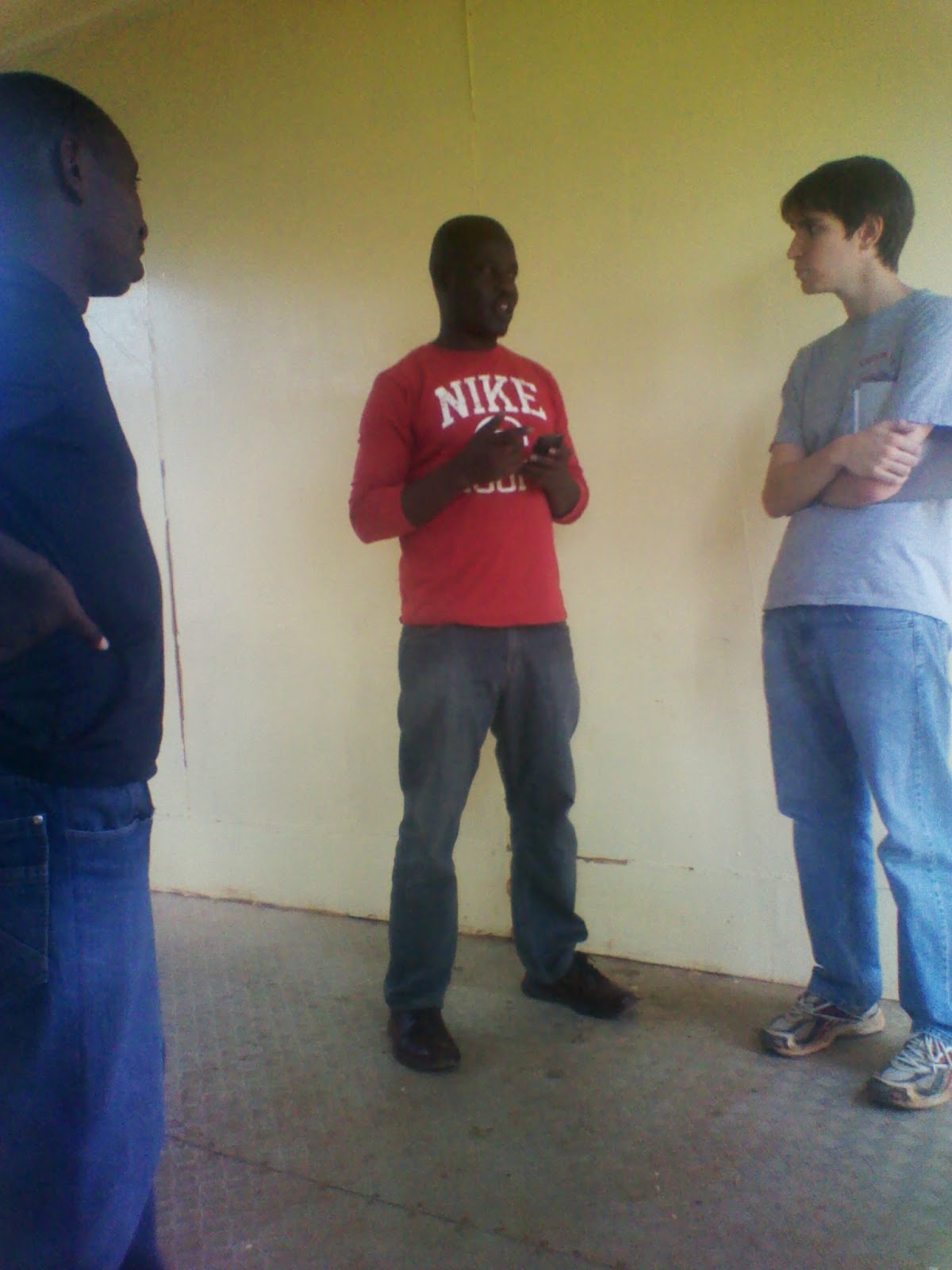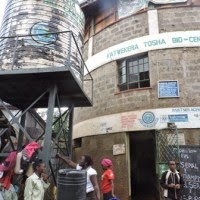Meet the Bio-Centres: St. Christine Bio-Centre and School
As I trekked across Kibera to the St. Christine Bio-Centre and School, I was not quite sure what to expect. I had been told St. Christine “has a lot going on” and there would be plenty of great things there, but I was still left curious. When we finally reached our destination, a compound just off the highway, we entered a small metal gate that opened up into a community filled with festive children, passionate teachers, and all kinds of inspiring projects.
 St. Christine Bio-Centre
and School truly has it all: latrines, showers, a solar lamp community
distribution project, a computer lab, and green space initiatives. Working in
partnership, Umande Trust and the St.
Christine School have accomplished a great many things in the past few years. Since
both the Bio-Centre and School’s inception, a world of possibilities has opened
up for the School and surrounding community’s growth. And by the looks of it
after I finished my tour, it was clear to me that those involved in the
Bio-Centre and School’s success had no intention of stopping.
St. Christine Bio-Centre
and School truly has it all: latrines, showers, a solar lamp community
distribution project, a computer lab, and green space initiatives. Working in
partnership, Umande Trust and the St.
Christine School have accomplished a great many things in the past few years. Since
both the Bio-Centre and School’s inception, a world of possibilities has opened
up for the School and surrounding community’s growth. And by the looks of it
after I finished my tour, it was clear to me that those involved in the
Bio-Centre and School’s success had no intention of stopping.
Beginning our tour,
the first stop we made was the Bio-Centre toilets and showers. We were told the
toilets have served a great benefit to the students for purposes of both sanitation
and convenience, but also in terms of student awareness and knowledge of what
proper sanitation looks like. Adding to this, there was even a colorful mural
above the sinks that mapped the hazardous germs that spread when students skip
washing their hands.
 Next, we moved
upstairs to check out a solar lamp distribution project the School has
launched. The lamps, which can be both charged or receive power from sunlight,
were donated by the United Nations. Beginning on December 5, these lamps will
begin to be distributed to targeted community members in need. A small fee will
be charged, but only to cover the cost of charging the lamps. On the walk back
to the Umande HQ after our tour, I realized this was a noble project. The
project offered little benefit to the School itself, but rather was an
outward directed project that hopes to cater to the surrounding community and
beyond. This project is being tested out here and will be expanded if the pilot
goes well.
Next, we moved
upstairs to check out a solar lamp distribution project the School has
launched. The lamps, which can be both charged or receive power from sunlight,
were donated by the United Nations. Beginning on December 5, these lamps will
begin to be distributed to targeted community members in need. A small fee will
be charged, but only to cover the cost of charging the lamps. On the walk back
to the Umande HQ after our tour, I realized this was a noble project. The
project offered little benefit to the School itself, but rather was an
outward directed project that hopes to cater to the surrounding community and
beyond. This project is being tested out here and will be expanded if the pilot
goes well.
Next, we went upstairs
to see the cyber rooms. Due to a partnership with Umande and the Danish-based
organization SustainableEnergy (sustainableenergy.dk/),
the School was able to setup two cyber rooms. One room is designated for
community use and will soon have internet access, and the other room is for
students and has been equipped with outstanding educational software. This
software has a dictionary, picture dictionary, games, tests, and detailed progress
reports, among other things. If this wasn’t enough, the School is looking to
setup a digital library. The School told us that for Kibera, this is the first
cyber room at a school. Once the Bio-Centre was built, Umande continued to work
in partnership with the School to make this project happen, and Umande and St.
Christine are excited to say that it has become a great success.
After seeing the solar
lamps and computers, we headed upstairs to capture a fantastic view of
surrounding Kibera. As students setup chairs for pre-exam prayer later that
afternoon, our group spoke about how far St. Christine had come and how
beneficial its programs are proving to be for students there. Inside the walls
of St. Christine, one finds a centre students can be nurtured and grow in
safely as a result of the School’s dedication to them and the partnerships they
maintain with organizations like Umande.
 Next, we headed
downstairs to check out more of the campus. Upon walking out of the School side
of the Bio-Centre, I became intrigued by a peculiar structure next to the
courtyard. It was a series of shipping crates stacked all on top of each other. I was told it was to be the School’s
secondary school, all they needed was stairs. Each crate would serve as one
classroom and there were doorways and windows cut out in each of them. I
thought it was an incredibly innovative idea. Who would have thought that shipping crates could do so much.
Next, we headed
downstairs to check out more of the campus. Upon walking out of the School side
of the Bio-Centre, I became intrigued by a peculiar structure next to the
courtyard. It was a series of shipping crates stacked all on top of each other. I was told it was to be the School’s
secondary school, all they needed was stairs. Each crate would serve as one
classroom and there were doorways and windows cut out in each of them. I
thought it was an incredibly innovative idea. Who would have thought that shipping crates could do so much.
Finally, I learned of one
final project just before we left. This project is one often underestimated:
green space. As most may know, Kibera is not home to many trees, vegetation, or
grass in general. This has led to problems; for example, polluting erosion in Kibera is
far more free-flowing without much plant-life. Moreover, green spaces encourage
community activities and integration, in addition to creating an overall attractiveness
in society. In concern to the lack of green spaces, litter, and pollution in
Kibera, one of the School teachers told me that “[students can’t] let what they
see in Kibera last when they leave.” Because of this, in the past the School
has started a vegetable garden, and hopes to one day transform the central courtyard
into a grassy area students can congregate, play, and hold events in.
Overall, the St.
Christine Bio-Centre and School are astounding facilities. It goes to show how
far you can go with the committed and collective effort of many community members
and partners all dedicated to a few common causes. Currently and in the past,
St. Christine has worked with a variety of NGOs and inter-governmental
organizations, including Umande Trust,
Under the Same Sky, SustainableEnergy, and the United
Nations. The work done at St. Christine is so inspiring because these
organizations did not settle for the standard many have come to expect in the
surrounding community, but they pushed beyond this to give students the
resources, and in turn the capabilities, they felt students everywhere are
entitled to. What students carry from this institution will last a lifetime,
and Umande is proud to be a partner of such a phenomenal establishment.
Written by Alex Young, Business Intern




Comments
Post a Comment